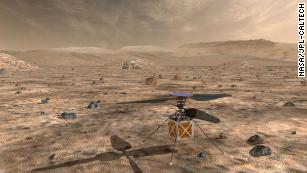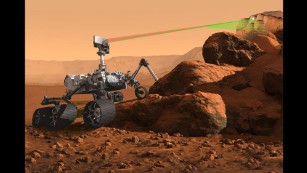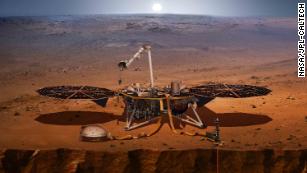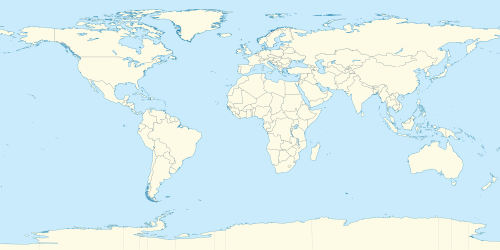Organic matter has been found on Mars in soil samples taken from 3 billion-year-old mudstone in the Gale crater by the Curiosity rover, NASA announced Thursday. The rover has also detected methane in the Martian atmosphere.
The search for life outside Earth focuses on the building blocks of life as we know it, which includes organic compounds and molecules -- although these can exist without life. Organic matter can be one of several things: a record detailing ancient life, a food source for life or something that exists in the place of life.
No matter its purpose, these work as "chemical clues" for researchers about Mars.
Methane is considered the simplest organic molecule. It's present in other places in our solar system that could host life, like Saturn and Jupiter's moons Enceladus, Europa and Titan. And if life does exist elsewhere, it may be very different or even form differently from how we understand life on Earth.
The new findings are also detailed in two studiespublished Thursday in the journal Science. Together, the researchers believe these findings to be "breakthroughs in astrobiology."
"We have greatly expanded our search for organic compounds, which is fundamental in the search for life," said Paul Mahaffy, study author and director of the Solar System Exploration Division at NASA's Goddard Space Flight Center.
The two studies build on and advance smaller detections of atmospheric methane and ancient organic compounds on Mars. Those detections either caused debate or lacked the context for understanding, the researchers said.
But Curiosity's data are providing a clearer and more conclusive picture of the conditions and processes on Mars -- and what it may have been like on the Red Planet billions of years ago, when conditions were more suitable for life.
"With these new findings, Mars is telling us to stay the course and keep searching for evidence of life," said Thomas Zurbuchen, associate administrator for the Science Mission Directorate at NASA Headquarters. "I'm confident that our ongoing and planned missions will unlock even more breathtaking discoveries on the Red Planet."
Finding clues beneath the surface
We've been exploring the surface of Mars in hopes of understanding the Red Planet since NASA's Viking mission in the 1970s. The Viking Project was the first US mission to safely land spacecraft on the Martian surface, as well as send back images.
And although hopes were high that the two landers and their instruments would detect signs of life or organic compounds in samples taken from the surface, that didn't happen.
Decades later, Viking helped inspire the instruments on today's Martian rovers. And Curiosity dug a little deeper beneath the surface, which is blasted with radiation, to see what stories the soil had to tell.
Curiosity sampled sites by drilling five centimeters below the surface in the Gale crater, which is where the rover landed in 2012. The 96-mile crater, named for Australian astronomer Walter F. Gale, was most likely formed by meteor impact between 3.5 to 3.8 billion years ago. It likely held a lake, and now includes a mountain.
The rover was able to heat the samples to between 932 and 1508 degrees Fahrenheit and study the organic molecules released through gas analysis. The organic molecules and volatiles, comparable to samples of sedimentary rock rich in organics on Earth, included thiopene, methylthiophenes methanethiol and dimethylsulfide.
They don't exactly roll off the tongue, but researchers believe that these are fragments of larger molecules that were present on Mars billions of years ago. And the high amount of sulfur in the samples is most likely how they've lasted so long, the researchers said. Drilling beneath the surface, rather than sampling what was on top like Viking did, also helped.
Potential contaminants were analyzed and accounted for, so the results are the most conclusive yet.
"The Martian surface is exposed to radiation from space," said Jen Eigenbrode, a study author and research scientist at the Goddard Space Flight Center. "Both radiation and harsh chemicals break down organic matter. Finding ancient organic molecules in the top 5 centimeters of rock that was deposited when Mars may have been habitable bodes well for us to learn the story of organic molecules on Mars with future missions that will drill deeper."
Methane in the air
Over five years, Curiosity has used its Tunable Laser Spectrometer to measure methane in the atmosphere at the Gale crater. Before, researchers couldn't understand why the little bit of methane detected in the Martian atmosphere varied. With five years of data from a single location, they now have answers.
There is a seasonal variation to the methane that repeats, which means the methane is being released from the Martian surface or from reservoirs beneath the surface. The methane could even be trapped in water-based crystals beneath the surface.
Methane is a strong greenhouse gas, and it could have supported a climate that sustained lakes on Mars. That could even be happening beneath the surface now, the researchers said. The release of methane is an active process on Mars, which could suggest new things about what's unfolding on the Red Planet.
Detecting this organic molecule in the atmosphere, combined with the finding of organic compounds in the soil, has strong implications about potential life on Mars in its past.
The Gale Crater was probably habitable 3.5 billion years ago, based on what Curiosity has shown us. Then, the conditions would have been comparable to Earth. This is also when life was evolving on our own planet.
Knowing that these molecules and compounds were present, then, gives new strength to the idea that life originated or existed on Mars and that more work by the Martian rovers can uncover the past.
NASA's InSight Lander, launched on May 5, will land on Mars on November 26. Its two-year mission will explore Mars to see if it's "geologically alive," or active below the surface. For example, scientists want to know if it has "Mars quakes." And the Mars 2020 rover, which is expected to launch July 2020, may be able to assist with one day retrieving soil samples from Mars.
"Are there signs of life on Mars?" asked Michael Meyer, lead scientist for the Mars Exploration Program at NASA Headquarters. "We don't know, but these results tell us we are on the right track."
















